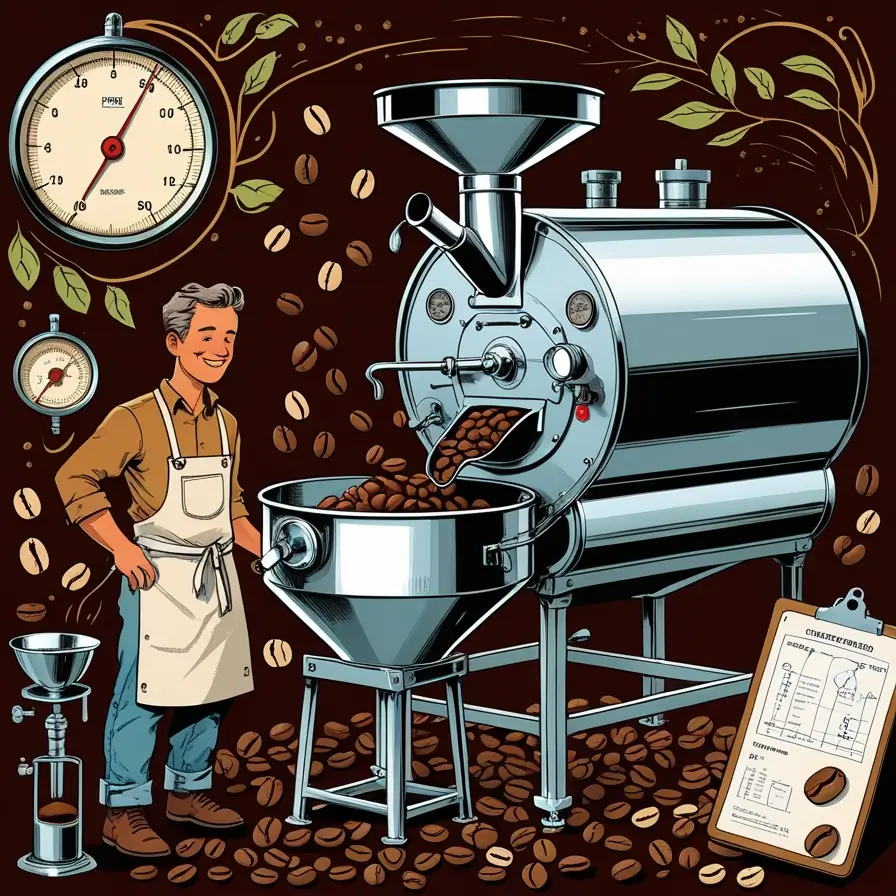Coffee Chemistry: 6 Mind-Blowing Secrets From Bean to Brew

Coffee is one of the most widely consumed beverages in the world, with millions of people starting their day with a freshly brewed cup. But have you ever wondered about the complex Coffee chemistry within those humble coffee beans? From their vibrant green origins to the rich, complex flavors that develop during roasting, the journey of the coffee bean is a fascinating scientific story.
1. The Green Beans: Unraveling the Secrets of Unroasted Coffee

When coffee beans are first harvested, they are green in color and possess a vastly different chemical composition than the coffee we know and love. These green, unroasted beans are the starting point for the coffee-making process, and understanding their chemistry is the key to unlocking the secrets of the final product.
One of the most important compounds in green coffee beans is chlorogenic acid, which can make up as much as 10% of the bean’s dry weight. This compound is responsible for the bean’s natural bitterness, astringency, and antioxidant properties. As the beans are roasted, the chlorogenic acid content decreases, leading to a reduction in bitterness and a more balanced flavor profile.
In addition to chlorogenic acid, green coffee beans contain various other compounds, including caffeine, trigonelline, and amino acids. Caffeine is the stimulant that gives coffee its energizing effects, while trigonelline is a precursor to the complex flavors that develop during roasting. The amino acids present in green beans, such as glutamic acid and aspartic acid, contribute to the beans’ inherent umami qualities.
2. The Roasting Process: Unlocking the Secrets of Aroma and Flavor

The transformation from green beans to the aromatic, flavorful coffee we know and love occurs during the roasting process. This is where the real magic happens, as the heat and chemical reactions work together to create the unique characteristics we associate with our favorite coffee blends.
The roasting process begins with the application of heat, typically between 370°F and 540°F (190°C to 280°C). As the beans are exposed to this intense heat, a series of chemical reactions take place, collectively known as the Maillard reaction. This complex series of reactions involves the interaction between amino acids and reducing sugars, leading to the formation of hundreds of different aromatic compounds.
One key component of the Maillard reaction is the breakdown of chlorogenic acid. As the beans are roasted, the chlorogenic acid is transformed into a variety of other compounds, including quinic acid and caffeic acid. These compounds contribute to the development of the coffee’s acidity and body, as well as its unique flavor profile.
In addition to the Maillard reaction, the roasting process also triggers the caramelization of the beans’ natural sugars. As the sugars are heated, they undergo a series of chemical transformations that result in the formation of caramel-like compounds. These compounds are responsible for the sweet, nutty, and even chocolate-like flavors that are often associated with well-roasted coffee.
The duration and temperature of the roasting process play a critical role in the final flavor profile of the coffee. Lighter roasts, which are roasted for a shorter period at lower temperatures, tend to have a more pronounced acidity and a brighter, more nuanced flavor. Darker roasts, on the other hand, are roasted for a longer time at higher temperatures, resulting in a deeper, more robust flavor with notes of caramel, chocolate, and even a hint of smokiness.
3. The Chemistry of Aroma: Unlocking the Secrets of Scent

One of the most captivating aspects of coffee is its aroma, which can range from floral and fruity to earthy and chocolatey. This incredible diversity of scents is the result of a complex interplay of volatile organic compounds (VOCs) that are released during the roasting process.
As the beans are roasted, hundreds of different VOCs are generated, each contributing to the overall aroma of the coffee. These compounds include a wide range of esters, alcohols, aldehydes, and ketones, all of which possess unique scent profiles.
For example, the presence of compounds like 2-methylpyrazine, 2-furfurylpyridine, and 2-acetylpyrrole can impart nutty, roasted, and caramel-like aromas to the coffee. Meanwhile, compounds like 2-isobutyl-3-methoxypyrazine and 2-methoxy-4-vinylphenol can contribute to the green, grassy, and herbal notes that are often found in lighter roasts.
The specific aroma profile of a coffee is influenced by various factors, including the bean’s origin, the roasting method, and even the brewing technique. By understanding the chemistry of coffee aroma, roasters and baristas can better optimize the flavors and scents of their products, ensuring that each cup of coffee is a true sensory experience.
4. The Importance of Water Chemistry

While the chemistry of the coffee beans themselves is undoubtedly fascinating, it’s important to remember that the water used in the brewing process also plays a critical role in the final flavor profile.
The quality and mineral content of the water can significantly impact the extraction of the coffee’s compounds and the overall balance of the brew. For example, water with a high concentration of dissolved minerals, such as calcium and magnesium, can lead to a more bitter and astringent cup of coffee, as these minerals can interfere with the extraction of the coffee’s more delicate flavors.
Conversely, water with a lower mineral content, or “soft” water, can result in a brew that lacks body and complexity, as the lack of dissolved minerals can inhibit the full extraction of the coffee’s compounds.
To achieve the perfect balance, baristas, and coffee enthusiasts often experiment with different water sources or even use specialized water filtration systems to ensure that the water used for brewing is optimized for the specific coffee they are working with.
5. The Future of Coffee Chemistry: Innovations and Advancements
As our understanding of coffee chemistry continues to grow, we can expect to see a range of exciting innovations and advancements in the world of coffee. From the development of new roasting techniques to the exploration of novel coffee bean varieties, the future of coffee is sure to be filled with fascinating scientific discoveries.
One area of particular interest is the potential for genetic engineering and selective breeding to create coffee beans with enhanced flavor profiles and increased resistance to pests and diseases. By leveraging our understanding of the coffee bean’s genetic makeup, researchers and coffee growers may be able to develop new strains that are better suited to the challenges of a changing climate and consumer demand.
Additionally, as the specialty coffee industry continues to grow, we may see an increased focus on the development of advanced analytical tools and techniques that can help baristas and roasters better understand the complex chemistry of their coffee. From advanced gas chromatography-mass spectrometry (GC-MS) to machine learning-powered flavor analysis, the future of coffee science is sure to be both exciting and delicious.
6. Embracing the Coffee Chemistry
As we’ve explored in this article, the chemistry of coffee beans is a captivating and multifaceted topic, with the potential to unlock a deeper appreciation for this beloved beverage’s incredible complexity.
From the vibrant green origins of the unroasted bean to the rich, aromatic profiles that emerge during roasting, the journey of the coffee bean is a testament to the power of chemical reactions and the endless creativity of nature. By understanding the science behind coffee, we can not only improve the quality and consistency of our favorite brews but also gain a newfound respect for the incredible transformations that take place within every cup.
So, the next time you savor a freshly brewed cup of coffee, take a moment to appreciate the incredible chemistry that has brought it to your lips. And who knows, perhaps your newfound knowledge will inspire you to explore the world of coffee in even greater depth, unlocking the secrets of this captivating beverage one sip at a time.






